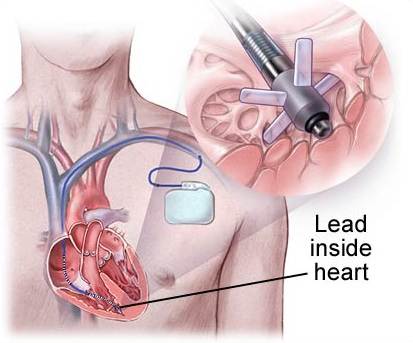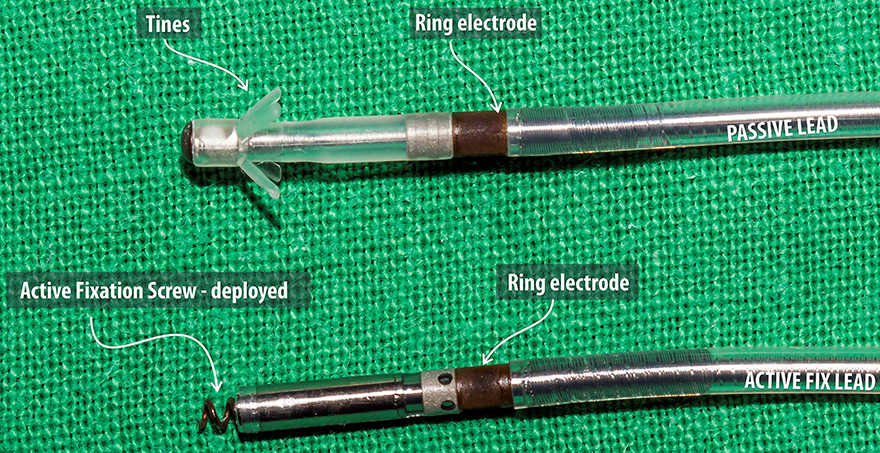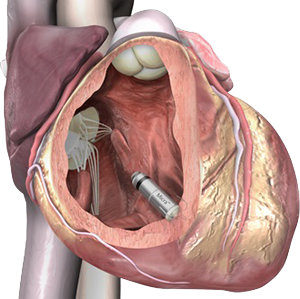Home /
Cardiac Pacemaker and Electrophysiology
Cardiac pacemaker electrophysiology
Electrical Impulse and Myocardium
- Under physiological conditions, electrical impulses are generated in the conduction system (SA node)
- Electric current is the flow of electrons through an electric circuit
- Electrons move from the anode (-) (negative electrode) to the cathode (+) (positive electrode)
- The direction of electric current is drawn oppositely in diagrams! (from cathode to anode)
- Ampere is the unit of electric current
- It expresses how many electrons pass through a conductor in 1 second
- Volt is the unit of electric voltage
- Volt is the force that "pushes" electrons
- Ohm is the unit of electric resistance
- It expresses how "difficult" it is for electrons to pass through a conductor
- A pacemaker electrode has low resistance, myocardium has high resistance
- If electric current passes through the myocardium (electrons)
- The myocardium is stimulated (depolarizes) and systole occurs

Electric Current, Pacemaker, and Myocardium
- The image shows a simple electric circuit with a battery connected to 2 electrodes on a part of the myocardium
- Electrons move from the anode (-) to the cathode (+) of the battery
- However, the direction of electric current is drawn oppositely in diagrams! (from cathode to anode)
- Anode (-) is the part of the electric circuit where electrons leave
- Cathode (+) is the part of the electric circuit where electrons arrive
- The anode and cathode in the circuit are relative terms
- The battery cathode is different from the pacemaker cathode (the electrode connected to the myocardium)
- To remember:
- A pacemaker (PCM) has a battery that intermittently sends electrons through electrodes to the myocardium
- The flow of electrons depolarizes the myocardium, causing systole
- From the cathode of the PCM, electrons enter the myocardium
- The cathode is in contact with the myocardium, so electrons from the battery arrive at the cathode
- The anode of the PCM receives electrons from the myocardium
- Electrons leave the anode and go to the battery
Bipolar and Unipolar Electrodes
- Every pacemaker (PCM) needs both a cathode and anode to stimulate the myocardium
- Intermittent electrons pass between them from the PCM battery
- Bipolar Electrode
- The electrode that goes from the PCM to the myocardium has both a cathode and anode at its tip
- Electrons pass between the tips of the electrode
- It is used more frequently than the unipolar type
- Unipolar Electrode
- The electrode that goes from the PCM to the myocardium has only a cathode
- The anode is the PCM itself
- Electrons pass between the electrode (cathode) and the PCM (anode) (the body is the electrical conductor)

Bipolar Electrode
- The cathode and anode are in the tip
- It is used more frequently

Unipolar Electrode
- Only the cathode is in the tip
- The anode is the PCM itself
Electrode Fixation
- Pacemaker
- is implanted under the skin, under the clavicle
- Electrodes
- are introduced through the subclavian vein into the appropriate chamber
- There are 2 methods of electrode fixation in the chamber
- Passive using barbs in the chamber trabeculae
- Active using a screw (screwed into the myocardium)


Bipolar Electrodes (Passive and Active Fixation)
- Both electrodes are bipolar (have both an anode and a cathode)
- Passive Electrode
- The tip of the electrode is introduced into the chamber, where there are muscle trabeculae
- Barbs catch onto the trabeculae
- Active Electrode
- Actively screws into the myocardium in the chamber

Pacemaker Connector and Electrode
- Each pacemaker has a connector into which the electrode is inserted
Leadless Pacemaker


Leadless Pacemaker
- Implanted into the right ventricle
- Does not have leads (like the traditional PCM)
Pacing and Sensing
- Pacing
- Pacing occurs when the PCM generates an impulse (current of electrons between the cathode and anode)
- It is the electrical stimulation (depolarization) of the myocardium
- On an ECG, it appears as pacing artifacts "vertical lines"
- Bipolar electrodes generate smaller pacing artifacts on the ECG than unipolar ones
- Sensing
- Each electrode (in addition to pacing) can detect the heart's own electrical activity
- Sensing is not visible on an ECG
- Sensing and pacing must be configured by a physician

Asynchronous Ventricular Pacing
- Pacing artifacts appear as vertical lines
- The pacemaker is in VOO mode
Sources
- ECG from Basics to Essentials Step by Step
- litfl.com
- ecgwaves.com
- metealpaslan.com
- medmastery.com
- uptodate.com
- ecgpedia.org
- wikipedia.org
- Strong Medicine
- Understanding Pacemakers
Home /
Cardiac Pacemaker and Electrophysiology
Cardiac pacemaker electrophysiology
Electrical Impulse and Myocardium
- Under physiological conditions, electrical impulses are generated in the conduction system (SA node)
- Electric current is the flow of electrons through an electric circuit
- Electrons move from the anode (-) (negative electrode) to the cathode (+) (positive electrode)
- The direction of electric current is drawn oppositely in diagrams! (from cathode to anode)
- Ampere is the unit of electric current
- It expresses how many electrons pass through a conductor in 1 second
- Volt is the unit of electric voltage
- Volt is the force that "pushes" electrons
- Ohm is the unit of electric resistance
- It expresses how "difficult" it is for electrons to pass through a conductor
- A pacemaker electrode has low resistance, myocardium has high resistance
- If electric current passes through the myocardium (electrons)
- The myocardium is stimulated (depolarizes) and systole occurs
|
|

Electric Current, Pacemaker, and Myocardium
- The image shows a simple electric circuit with a battery connected to 2 electrodes on a part of the myocardium
- Electrons move from the anode (-) to the cathode (+) of the battery
- However, the direction of electric current is drawn oppositely in diagrams! (from cathode to anode)
- Anode (-) is the part of the electric circuit where electrons leave
- Cathode (+) is the part of the electric circuit where electrons arrive
- The anode and cathode in the circuit are relative terms
- The battery cathode is different from the pacemaker cathode (the electrode connected to the myocardium)
- To remember:
- A pacemaker (PCM) has a battery that intermittently sends electrons through electrodes to the myocardium
- The flow of electrons depolarizes the myocardium, causing systole
- From the cathode of the PCM, electrons enter the myocardium
- The cathode is in contact with the myocardium, so electrons from the battery arrive at the cathode
- The anode of the PCM receives electrons from the myocardium
- Electrons leave the anode and go to the battery
Bipolar and Unipolar Electrodes
- Every pacemaker (PCM) needs both a cathode and anode to stimulate the myocardium
- Intermittent electrons pass between them from the PCM battery
- Bipolar Electrode
- The electrode that goes from the PCM to the myocardium has both a cathode and anode at its tip
- Electrons pass between the tips of the electrode
- It is used more frequently than the unipolar type
- Unipolar Electrode
- The electrode that goes from the PCM to the myocardium has only a cathode
- The anode is the PCM itself
- Electrons pass between the electrode (cathode) and the PCM (anode) (the body is the electrical conductor)

|

|
|
Bipolar Electrode
- The cathode and anode are in the tip
- It is used more frequently
|
Unipolar Electrode
- Only the cathode is in the tip
- The anode is the PCM itself
|
Electrode Fixation
- Pacemaker
- is implanted under the skin, under the clavicle
- Electrodes
- are introduced through the subclavian vein into the appropriate chamber
- There are 2 methods of electrode fixation in the chamber
- Passive using barbs in the chamber trabeculae
- Active using a screw (screwed into the myocardium)
|

|

Bipolar Electrodes (Passive and Active Fixation)
- Both electrodes are bipolar (have both an anode and a cathode)
- Passive Electrode
- The tip of the electrode is introduced into the chamber, where there are muscle trabeculae
- Barbs catch onto the trabeculae
- Active Electrode
- Actively screws into the myocardium in the chamber

Pacemaker Connector and Electrode
- Each pacemaker has a connector into which the electrode is inserted
Leadless Pacemaker

|

|
Leadless Pacemaker
- Implanted into the right ventricle
- Does not have leads (like the traditional PCM)
Pacing and Sensing
- Pacing
- Pacing occurs when the PCM generates an impulse (current of electrons between the cathode and anode)
- It is the electrical stimulation (depolarization) of the myocardium
- On an ECG, it appears as pacing artifacts "vertical lines"
- Bipolar electrodes generate smaller pacing artifacts on the ECG than unipolar ones
- Sensing
- Each electrode (in addition to pacing) can detect the heart's own electrical activity
- Sensing is not visible on an ECG
- Sensing and pacing must be configured by a physician

Asynchronous Ventricular Pacing
- Pacing artifacts appear as vertical lines
- The pacemaker is in VOO mode
Sources
- ECG from Basics to Essentials Step by Step
- litfl.com
- ecgwaves.com
- metealpaslan.com
- medmastery.com
- uptodate.com
- ecgpedia.org
- wikipedia.org
- Strong Medicine
- Understanding Pacemakers

















